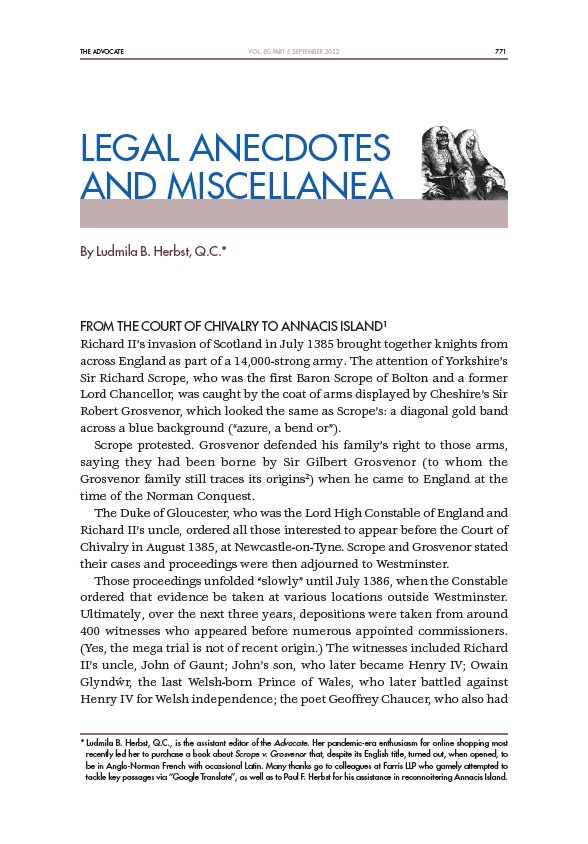
THE ADVOCATE 771
VOL. 80 PART 5 SEPTEMBER 2022
LEGAL ANECDOTES
AND MISCELLANEA
By Ludmila B. Herbst, Q.C.*
FROM THE COURT OF CHIVALRY TO ANNACIS ISLAND1
Richard II’s invasion of Scotland in July 1385 brought together knights from
across England as part of a 14,000-strong army. The attention of Yorkshire’s
Sir Richard Scrope, who was the first Baron Scrope of Bolton and a former
Lord Chancellor, was caught by the coat of arms displayed by Cheshire’s Sir
Robert Grosvenor, which looked the same as Scrope’s: a diagonal gold band
across a blue background (“azure, a bend or”).
Scrope protested. Grosvenor defended his family’s right to those arms,
saying they had been borne by Sir Gilbert Grosvenor (to whom the
Grosvenor family still traces its origins2) when he came to England at the
time of the Norman Conquest.
The Duke of Gloucester, who was the Lord High Constable of England and
Richard II’s uncle, ordered all those interested to appear before the Court of
Chivalry in August 1385, at Newcastle-on-Tyne. Scrope and Grosvenor stated
their cases and proceedings were then adjourned to Westminster.
Those proceedings unfolded “slowly” until July 1386, when the Constable
ordered that evidence be taken at various locations outside Westminster.
Ultimately, over the next three years, depositions were taken from around
400 witnesses who appeared before numerous appointed commissioners.
(Yes, the mega trial is not of recent origin.) The witnesses included Richard
II’s uncle, John of Gaunt; John’s son, who later became Henry IV; Owain
Glyndwˆ r, the last Welsh-born Prince of Wales, who later battled against
Henry IV for Welsh independence; the poet Geoffrey Chaucer, who also had
* Ludmila B. Herbst, Q.C., is the assistant editor of the Advocate. Her pandemic-era enthusiasm for online shopping most
recently led her to purchase a book about Scrope v. Grosvenor that, despite its English title, turned out, when opened, to
be in Anglo-Norman French with occasional Latin. Many thanks go to colleagues at Farris LLP who gamely attempted to
tackle key passages via “Google Translate”, as well as to Paul F. Herbst for his assistance in reconnoitering Annacis Island.